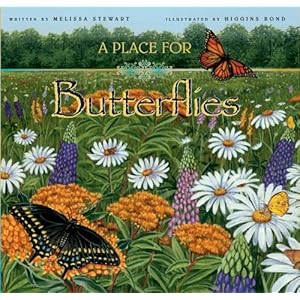Melissa Stewart's book A Place for Butterflies was a perfect addition to this lesson--and a great way to share the problem/solution text structure. On each page, this book explains a problem that butterflies face, and then shows a way that people have helped to solve this problem.
Modeling
We started by reviewing how ecosystems can change. I showed students the book, and explained that the author explains problems and solutions in the ecosystem.
Then students made their own problem and solution charts. I modeled on the chart paper, and then students created their own by folding a sheet of notebook paper.
I read aloud the first pages and explained how to find the problem and solution. We worked with the main text at first, skipping over the insets for the time being. While there aren't any traditional problem and solution cue words, the text follows a pattern. The problem is presented on the left hand page, with the solution on the right.
As I shared the first few pages, I also showed students that there are more butterflies and caterpillars of each species hidden throughout the illustrations. I have a very artistic class this year, and they loved this little touch.
Group Work
We purchased 7 books over the summer, so students could work in groups of 3-4 to read the rest of the book. Because it's available in paperback, this is a very affordable addition to our science library.
Students quickly scattered throughout the room to work in their small groups. They continued reading and finding problems and solutions. Although this text is listed as an easier book, with some recommending it for K-3, my fourth graders found it the perfect challenge.
As they worked, I went around the room and listened to them. Many groups had problems with the idea that letting natural wildfires burn could be helpful for butterflies! We had talked about natural and human-caused forest fires. Living where we do, though, they had no experience with beneficial forest fires.
Some groups also didn't know what "cattle" were. I coached them to use the supportive illustrations to figure it out.
I chose one group to sit next to the easel to continue the chart that I had started. Of course, this was a highly coveted position!
Differentiation
My students work at vastly different speeds. This book was perfect for us. After they finished the main text, groups could go back and read the insets or find the butterflies and caterpillars hidden on each page. Many chose to go back to the natural wildfires page, because it was so puzzling for them. (I'll have to find more resources for this, since they find it so interesting.)
Discussion and Debriefing
These questions helped to frame our discussion after reading. You'll notice that they are a mix of reading questions and science questions.
-Why was the text structure of problem and solution a good fit for this book?
-Which set of problems and solutions surprised you? Which confirmed what you have learned before?
-How did the illustrations add to the text?
-Which of the solutions have we tried? Which could we try in our area?





No comments:
Post a Comment